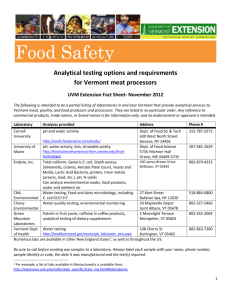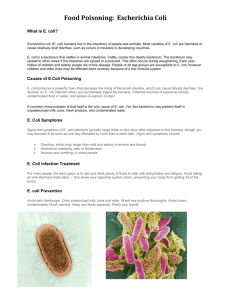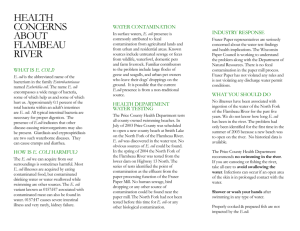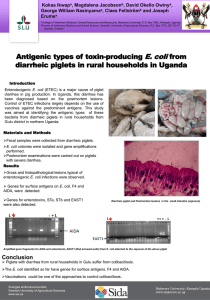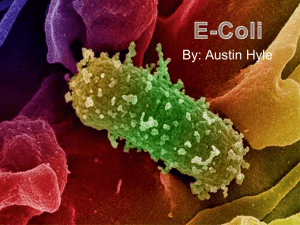Oct 2010 - Food Safety Centre
advertisement
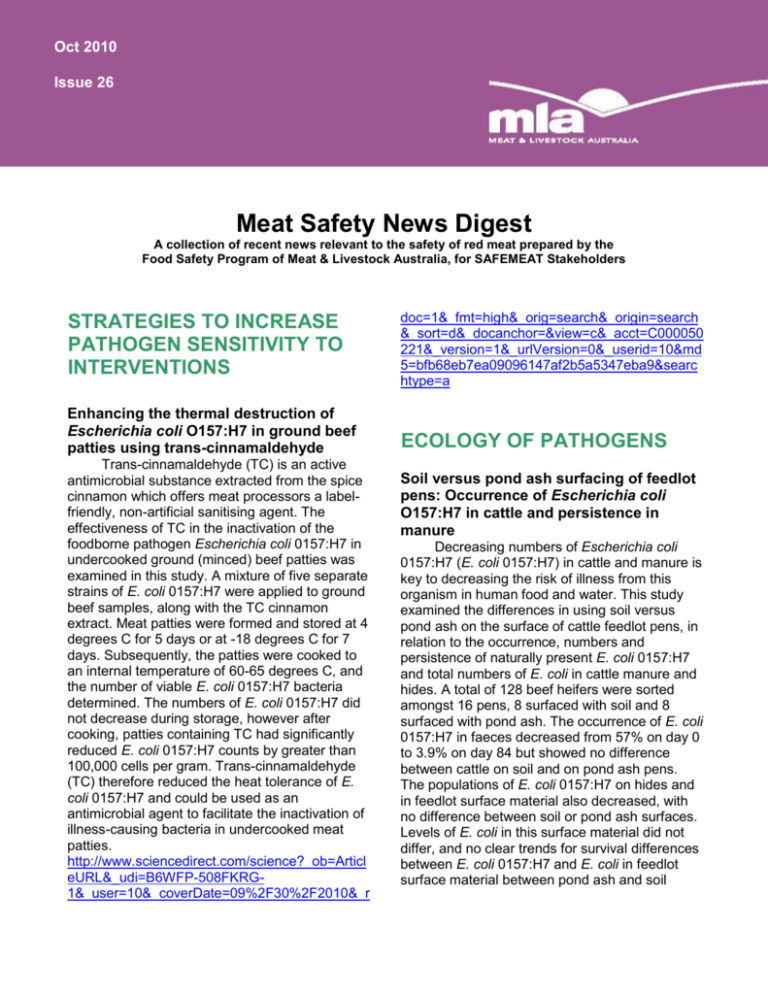
Oct 2010 Issue 26 Meat Safety News Digest A collection of recent news relevant to the safety of red meat prepared by the Food Safety Program of Meat & Livestock Australia, for SAFEMEAT Stakeholders STRATEGIES TO INCREASE PATHOGEN SENSITIVITY TO INTERVENTIONS Enhancing the thermal destruction of Escherichia coli O157:H7 in ground beef patties using trans-cinnamaldehyde Trans-cinnamaldehyde (TC) is an active antimicrobial substance extracted from the spice cinnamon which offers meat processors a labelfriendly, non-artificial sanitising agent. The effectiveness of TC in the inactivation of the foodborne pathogen Escherichia coli 0157:H7 in undercooked ground (minced) beef patties was examined in this study. A mixture of five separate strains of E. coli 0157:H7 were applied to ground beef samples, along with the TC cinnamon extract. Meat patties were formed and stored at 4 degrees C for 5 days or at -18 degrees C for 7 days. Subsequently, the patties were cooked to an internal temperature of 60-65 degrees C, and the number of viable E. coli 0157:H7 bacteria determined. The numbers of E. coli 0157:H7 did not decrease during storage, however after cooking, patties containing TC had significantly reduced E. coli 0157:H7 counts by greater than 100,000 cells per gram. Trans-cinnamaldehyde (TC) therefore reduced the heat tolerance of E. coli 0157:H7 and could be used as an antimicrobial agent to facilitate the inactivation of illness-causing bacteria in undercooked meat patties. http://www.sciencedirect.com/science?_ob=Articl eURL&_udi=B6WFP-508FKRG1&_user=10&_coverDate=09%2F30%2F2010&_r doc=1&_fmt=high&_orig=search&_origin=search &_sort=d&_docanchor=&view=c&_acct=C000050 221&_version=1&_urlVersion=0&_userid=10&md 5=bfb68eb7ea09096147af2b5a5347eba9&searc htype=a ECOLOGY OF PATHOGENS Soil versus pond ash surfacing of feedlot pens: Occurrence of Escherichia coli O157:H7 in cattle and persistence in manure Decreasing numbers of Escherichia coli 0157:H7 (E. coli 0157:H7) in cattle and manure is key to decreasing the risk of illness from this organism in human food and water. This study examined the differences in using soil versus pond ash on the surface of cattle feedlot pens, in relation to the occurrence, numbers and persistence of naturally present E. coli 0157:H7 and total numbers of E. coli in cattle manure and hides. A total of 128 beef heifers were sorted amongst 16 pens, 8 surfaced with soil and 8 surfaced with pond ash. The occurrence of E. coli 0157:H7 in faeces decreased from 57% on day 0 to 3.9% on day 84 but showed no difference between cattle on soil and on pond ash pens. The populations of E. coli 0157:H7 on hides and in feedlot surface material also decreased, with no difference between soil or pond ash surfaces. Levels of E. coli in this surface material did not differ, and no clear trends for survival differences between E. coli 0157:H7 and E. coli in feedlot surface material between pond ash and soil surfaces. It was however noted that E. coli populations survived in surface material at a high level 6 weeks after removal of cattle. In conclusion, housing cattle in pens surfaced with pond ash versus plain soil does not affect the presence of E. coli 0157:H7 in cattle or their manure. http://www.ingentaconnect.com/content/iafp/jfp/2 010/00000073/00000007/art00008 INTERVENTIONS Oral delivery systems for encapsulated Bacteriophages targeted at Escherichia coli O157:H7 in feedlot cattle Bacteriophages, (or ‘phages’), are small virus-like particles and natural predators of bacteria. In this study they are investigated as potential control agents for E. coli 0157:H7 in cattle and their surrounding environment. As acidity (such as in the rumen) causes phages to lose activity, to be effective as an E. coli 0157:H7 control when administered orally it is suggested that protection from gastric acidity is required. To this end, four phages, wV8, rV5, wV7 and wV11 were coated in a polymer and exposed to acid conditions (pH 3.0 for 20 mins), which lead to recovery of 13.6% of viable phages. Untreated phages under similar conditions were completely inactivated. Steers were innoculated with acidresistant E. coli 0157:H7 and placed in six pens of four steers each. Two pens received polymerencapsulated phages orally in gelatine capsuals, two received phages top-dressed on feed and two were given no phages as a control. Shedding of E. coli 0157:H7 was monitored for 10 weeks by collecting faecal and hide swab samples. Though phages were found to be active in the study, they had little apparent effect on reducing the shedding of acid-resistant E. coli 0157:H7. They did, however, reduce the duration of shedding by 14 days. While two successful delivery systems for phages in cattle were developed, their effectiveness against E. coli 0157:H7 was not proved and requires further study. http://www.ingentaconnect.com/content/iafp/jfp/2 010/00000073/00000007/art00012 Reduction of multidrug-resistant and drug-susceptible Salmonella in ground beef and freshly harvested beef briskets after exposure to commonly used industry antimicrobial interventions Two studies sought to determine the differences in the degree to which growth of multidrug-resistant (MDR) and drug-susceptible Salmonella are inhibited by antimicrobial treatments commonly used in beef processing facilities. The first study inoculated separate beef trim samples from a commercial processing facility with one multidrug-resistant and one drugsusceptible Salmonella strain, after which antimicrobial treatments were applied, including 3% lactic acid, 1,000 ppm acidifed sodium chloride (salt), and water at ambient temperature. A control sample was inoculated with the same Salmonella strain and left untreated. Samples were ground, formed into patties and wrapped in modified atmosphere (low-oxygen) packaging; samples were tested after storage for 0, 7, 10 and 14 days. In a second study, beef briskets were collected directly after slaughter and inoculated with the two Salmonella strains as above and subjected to the same antimicrobial treatments, with the addition of heat, and an extra hot water treatment. All beef briskets were refrigerated and sampled for microbiological testing at 0, 6 and 24 hours. In the first study, the most effective treatments were 3% lactic acid, then 1000 ppm acidified sodium chloride, followed by the water wash last; (the multidrugresistant Salmonella strain actually increased in numbers after the water treatment). In the second study, the most effective microbial treatment was 3% lactic acid, followed by acidified sodium chloride (salt), hot water and lastly a water wash. Significant differences in growth between multidrug resistant and drug-susceptible Salmonella after the anti-microbial treatments was not detected, indicating that both strains of this pathogenic bacteria are inactivated in a similar manner by common meat treatments used in processing facilities. http://www.ingentaconnect.com/content/iafp/jfp/2 010/00000073/00000007/art00004 PATHOGENICITY Relative gene transcription and pathogenicity of Enterohemorrhagic Escherichia coli after long-term adaptation to acid and salt stress This study examines the mechanisms by which Enterohaemorrhagic E. coli (EHEC) can react to environmental stresses, including acid environments and high salt levels, and become more virulent (or vigorous in causing illness). The genes which help E. coli to develop this stress tolerance and virulence are also identified. The study showed that long-term adaptation to food related bacterial stress factors, such as salt and acid stress, leads to the passing-on of stress-response genes which increases the virulence potential, (or the ability of EHEC to cause illness in humans), as measured by adhesion to surface cells of the human colon. http://www.sciencedirect.com/science?_ob=Articl eURL&_udi=B6T7K-506W6H21&_user=10&_coverDate=07%2F15%2F2010&_r doc=1&_fmt=high&_orig=search&_origin=search &_sort=d&_docanchor=&view=c&_acct=C000050 221&_version=1&_urlVersion=0&_userid=10&md 5=f5eb73f4967d42fe615ae90c820f5067&searcht ype=a MICROBIAL PREVALENCE Prevalence of multidrug resistance is higher among bovine than human Salmonella Newport, typhimurium and 4,5,12:i:- Isolates, but differs by serotype and geographic region in the US Salmonella is an important human pathogen, however its methods of transmission between humans and animals and within animal populations is not well understood. In this study Salmonella isolates from cattle and humans in two regions of the US were identified, and the distribution of resistance of the strain to antimicrobial treatments was tested. For Salmonella Newport and Salmonella Typhimurium, multidrug resistance was significantly associated with cattle isolates; for Newport strain drug resistance was 18 times higher than for human isolates. These results are consistent with the idea that cattle are an important source of multidrug-resistant Salmonella infections in humans. The study also highlights the value of including antimicrobial data in epidemiological investigations in the event of an illness outbreak. http://aem.asm.org/cgi/content/abstract/AEM.003 77-10v1?etoc Occurrence of Shiga toxin-producing E. coli (STEC) on carcasses and retail beef cuts in the marketing chain of beef in Argentina Argentina has the highest incidence of food-borne disease related to E. coli 0157:H7 (STEC) and non-0157 in the world. Cattle manure and hides are sources of STEC contamination during slaughter. This research investigates the presence of STEC in Argentinean meat cuts and in the marketing chain, using genetic methods. In carcasses, 12.34% and 18.64% were positive for STEC at a slaughter location and a storage facility for carcases, respectively. This increased to 24.53% at butcheries, and 25% of retail cuts of meat were STEC positive; (minced meat was very high at 40.74%). In this study, the stx2 gene was the predominant gene detected in all samples at different points in the meat supply chain, and indicated the presence of E. coli 0157:H7. http://www.sciencedirect.com/science?_ob=Articl eURL&_udi=B6T9G-5051PS69&_user=10&_coverDate=10%2F31%2F2010&_r doc=1&_fmt=high&_orig=search&_origin=search &_sort=d&_docanchor=&view=c&_acct=C000050 221&_version=1&_urlVersion=0&_userid=10&md 5=742d235447d62ed6cf4a4125dd44a078&searc htype=a METHODS Rapid Microarray-Based genotyping of Enterohemorrhagic Escherichia coli Serotype O156:H25/H-/Hnt isolates from cattle and clonal relationship analysis Isolates of enterohaemorrhagic (EHEC), E. coli 0156:H26, have been obtained from human patients. In this study cattle were examined as a potential source for these pathogenic bacteria. Genetic methods were used to isolate E. coli 0156:H26 from three cattle farms. Testing revealed some of the strains had the genetic potential for long persistence in a host and on the farm, and as indicated by multiple virulence markers, E. coli 0156:H25 isolates derived from cattle were shown to present a significant risk of infection for humans. The test used in the study (a miniaturised oligonucleotide array) was found to be an effective tool in the rapid detection of a wide range of virulence markers. http://aem.asm.org/cgi/content/abstract/76/16/55 10?etoc Evaluation of the SimPlate method for enumeration of Escherichia coli in swab samples from beef and lamb carcasses As part of compulsory HACCP monitoring practices, abattoirs are required to assess numbers of Escherichia coli (E. coli) on carcass surfaces; therefore rapid and reliable methods are required. In this study conventional microbiological plating methods; (the pour plate method) are compared with the rapid enzymatic method of SimPlate Coliforms and E. coli. Cattle and lamb carcases were swabbed in four places with cotton cloths, (at three Norwegian abattoirs), and samples were tested for E. coli. Results showed a high level of agreement between the two methods. It was therefore concluded that the enzyme-based SimPlate method is an accurate and rapid method for the detection and counting of E. coli, and is a suitable replacement method for use with swab samples from cattle and lamb carcases. http://www.sciencedirect.com/science?_ob=Articl eURL&_udi=B6T7K-50HYG033&_user=10&_coverDate=08%2F15%2F2010&_r doc=1&_fmt=high&_orig=search&_origin=search &_sort=d&_docanchor=&view=c&_acct=C000050 221&_version=1&_urlVersion=0&_userid=10&md 5=104478c621b67b8f54e4bca4875f3b2b&search type=a An Enzyme-linked Immunosorbent (ELISA) assay for the determination of cyromazine and melamine residues in animal muscle tissues Cyromazine is an insecticide, and together with its break-down product melamine, is toxic to humans and animals. This study successfully developed a rapid method (an enzyme linked immunosorbent assay or ELISA test) for determination of both cyromazine and melamine levels in animal meats. Results of the new method were confirmed by comparison with a standard High Performance Liquid Chromotagraphy (HPLC-UV) method. http://www.sciencedirect.com/science?_ob=Articl eURL&_udi=B6T6S-4YYXJKFV&_user=10&_coverDate=11%2F30%2F2010&_ rdoc=1&_fmt=high&_orig=search&_origin=search &_sort=d&_docanchor=&view=c&_acct=C000050 221&_version=1&_urlVersion=0&_userid=10&md 5=53aa202cd297906f331f375b13cfb191&searcht ype=a PATHOGENS AND BIOFILMS Removal of Listeria monocytogenes Biofilms with Bacteriophage P100 The treatment of food pathogens with bacteriophage, (tiny virus-like particles that infect bacterial cells and inactive them, commonly referred to as ‘phage’), is an emerging area of research, with phage first discovered in the early 20th Century. In this study the foodborne pathogen Listeria monocytogenes, which has a strong ability to form a protective coating or ‘biofilm’ against environmental stresses, was exposed to bacteriophage P100 to observe its degree of resistance. 21 different strains of L. monocytogenes, of differing biofilm-forming ability, were exposed to phage on a stainless steel surface. Results indicated the phage P100 treatment significantly reduced L. monocytogenes numbers, irrespective of strain, biofilm forming ability or growth conditions. Thus it was concluded that phage P100 is active against a wide range of biofilm-forming L. monocytogenes strains. http://www.ingentaconnect.com/content/iafp/jfp/2 010/00000073/00000008/art00017 Survival of Salmonella on a polypropylene surface under dry conditions in relation to Biofilm-formation capability The survival of Salmonella on a polpropylene surface, in relation to this bacteria’s ability to form a protective mat or ‘biofilm’, was the subject of this study. Dry conditions were simulated by growing selected Salmonella strains on polypropylene discs in a very low humidity dessication chamber. Salmonella strains were selected based on their degree of ability to form biofilms. The bio-film forming strains survived longer on the plastic discs than did those that showed little biofilm-forming ability. Material outside the bacterial cells was observed to be present on the plastic disc surface for the biofilmforming strains, (but not for the biofilm-deficient strains), through examination under an electron microscope. This polymer-like substance may have protected the biofilm-forming strains from the stress of the low-moisture environment. The results indicate that biofilm-forming strains of Salmonella may present a greater risk of foodborne illness to humans by surviving for longer periods compared to strains with low biofilmforming ability. http://www.ingentaconnect.com/content/iafp/jfp/2 010/00000073/00000008/art00014 INTERVENTIONS Studies on disinfection mechanism of electrolysed oxidizing water on E. coli and Staphylococcus aureus The use of electrolysed oxidising water (EO water), a non-chemical bacterial treatment, is examined in this study. The antibacterial power of EO water on the pathogens E. coli and Staphylococcus aureus is 100% at 1 and 3 minutes exposure time respectively. This study also explored the mechanisms by which EO water operates at a molecular biological level to destroy pathogens. It was shown to cause leaching of DNA and potassium ions from cells through their membranes, the inactivation of essential cell enzymes, and the destruction of internal cell proteins. EO water was found to be an environment-friendly, non-toxic and highly efficient disinfection agent that has wide application. http://www.ingentaconnect.com/content/bpl/jfds/2 010/00000075/00000005/art00017 Probiotics and prebiotics in animal feeding for safe food production The use of ‘harmless’ microorganisms to decrease the numbers of illness-causing or ‘pathogenic’ bacteria in foods of animal origin is the subject of this review. Pathogenic gut bacteria in animals are a direct source of food contamination and human food-borne illness. Harmless bacteria (or probiotics) that act by competing against these pathogens, (a process called ‘competitive exclusion’) can populate the digestive tract of livestock and produce conditions that retard the growth of illnesscausing bacteria. Prebiotics are food materials that promote the growth of the probiotic bacteria. The ban of antibiotics as growth promoters (AGP’s) has increased the need for development of alternative methods of preventing pathogenic bacterial colonisation of the digestive tract of livestock. The management of the microbial population or ‘microbiota’ of the animal gut with new feed additives, such as probiotcs and prebiotics, may potentially allow control of the health of livestock and also provide a measure of control over dangerous pathogens in food of animal origin. While knowledge of the effect of these feed additives has increased, essential information related to impact on the host animal is incomplete. More information regarding the mechanisms by which prebiotics and probiotics function and is required, and clear demonstration of the health-promoting effects they produce. Genetic information on the composition and function of gut microbes will lead to more informed selection of specific prebiotics. Complementary combinations of the correct probiotics and prebiotics may decrease animal intestinal disease and remove specific pathogens and microbial disorders. This review summarises current knowledge on the contribution of gut microflora to host well-being, and reviews all available information on prebiotics and probiotics and their application in animal feeding. http://www.sciencedirect.com/science?_ob=Articl eURL&_udi=B6T7K-4YK2DXJ4&_user=10&_coverDate=07%2F31%2F2010&_r doc=1&_fmt=high&_orig=search&_origin=search &_sort=d&_docanchor=&view=c&_acct=C000050 221&_version=1&_urlVersion=0&_userid=10&md 5=cc5f9cb5eb7dfe8f73a55445882875c4&searcht ype=a The application of food safety interventions in primary production of beef and lamb: A review This review of food safety interventions (or treatments) to control illness-causing bacteria, yeasts and moulds for the production of safe red meat, examines the breadth of the beef and lamb supply chain, from “farm to fork”. Eight microorganisms were selected as the focus of the ‘PathogenCombat’ project: Shiga toxin producing E. coli (STEC), Mycobacterium avium subspecies paratuberculosis (Map), Listeria monocytogenes, Campylobacter jejuni, Penicillium nordicum, invasive Saccharomyces cerevisiae, Hepatitis E virus and tick borne Encephalitis virus. Using a review of pertinent scientific literature and a decision tree, the need for co-ordinated control of these pathogens is assessed. Control measures to decrease populations of these pathogens in ruminants prior to slaughter are reviewed, with respect to current regulations and guidelines for primary production. From the eight pathogens examined, two (STEC and Map) are likely to be effectively controlled by farm level interventions. Ruminants such as cattle and sheep are the main hosts of these two pathogens, therefore reduction in numbers of these in livestock should directly reduce human exposure through beef and lamb consumption. http://www.sciencedirect.com/science?_ob=Articl eURL&_udi=B6T7K-4Y34PSY1&_user=10&_coverDate=07%2F31%2F2010&_r doc=1&_fmt=high&_orig=search&_origin=search &_sort=d&_docanchor=&view=c&_acct=C000050 221&_version=1&_urlVersion=0&_userid=10&md 5=7849ab629ed05d18ba3578f43258bddc&searc htype=a Antimicrobial activity of essential oils against Escherichia coli O157:H7 in organic soil Soil can be a significant source of contamination of produce with pathogenic (illness-causing) bacteria prior to harvest. Demand for ‘natural’ non-synthetic pesticides, such as essential oils, to treat fruit and vegetables for these pathogens are increasing with higher demand for organically farmed products. This study examined the antimicrobial activity of a number of essential oils against E. coli 0157:H7 in soil. Two essential oils (cinnamaldehyde and eugenol) and two biopesticides (Ecotrol and Sporan) derived from essential oils, and an organic acid (acetic acid) were mixed with organic sandy soil and inoculated with five separate strains of E. coli 0157:H7, before incubation and microbiological testing. E. coli 0157:H7 populations in soil were significantly reduced with cinnamanaldehyde, Ecotrol, Sporan and acetic acid (vinegar). Reduction of E. coli 0157:H7 by Eugenol was not significant. In general, increases in essential oil concentrations caused reduced survival of E. coli 0157:H7 with all essential oils tested. The results indicate oils can reduce potential pathogen contamination of fresh organic produce at risk from contact with soil. http://www.sciencedirect.com/science?_ob=Articl eURL&_udi=B6T6S-4YYXJKFR&_user=10&_coverDate=11%2F30%2F2010&_ rdoc=1&_fmt=high&_orig=search&_origin=search &_sort=d&_docanchor=&view=c&_acct=C000050 221&_version=1&_urlVersion=0&_userid=10&md 5=2b312e542c6521e9de9008fb49afeb98&searc htype=a Survival of Listeria monocytogenes on a conveyor belt material with or without antimicrobial additives. This study investigated the survival of the pathogen Listeria monocytogenes on conveyor belts with and without antimicrobial additives, in the absence or presence of food residue from fish, meat and vegetables, at temperatures of 10, 25 and 37°C. L. monocytogenes was found to survive best at 10°C, and better at 25°C than at 37°C, on both treated and untreated conveyor belts. Reduction of bacterial populations was greater for belts treated with antimicrobials agents, but the effect was drastically reduced if food residue was present. At 37°C the numbers of bacteria decreased on both conveyor belt materials. It also appeared that numbers of L. monocytogenes only decreased on belts treated with antimicrobials when they were wet. Results indicated conveyor belts treated with antimicrobial additives are effective at reducing the numbers of bacteria on their surfaces at low temperatures when food residues are absent, and the belts are left wet and not rapidly dried. http://www.ncbi.nlm.nih.gov/pubmed/20655607 PROCESSING PLANT HYGIENE Titanium-coating of stainless steel as an aid to improved cleanability Wear on the surface of food processing equipment through repeated use and cleaning, even on materials like stainless steel, can leave pits and scratches capable of harbouring bacteria that can resist normal cleaning procedures. This study suggests that altering the chemistry of a processing surface can minimise this effect. Softened cellulose acetate sheets were pressed onto the surfaces of both new polished and used stainless steel to make an impression capable of being analysed by scanning electron microscopy, (and other methods), to give a close-up visual profile of the surface. This profile was then compared with an assessment of each surface’s hygiene and cleanability. Subsequently, the retention of microorganisms on fine polished stainless steel and titanium-coated fine polished stainless steel were assessed, both with and without the presence of a meat conditioning film. The titanium-coated stainless steel prevented the retention of bacteria and enhanced the removal of Escherichia coli and the meat conditioning film. http://www.sciencedirect.com/science?_ob=Articl eURL&_udi=B6T7K-5023KD31&_user=10&_coverDate=07%2F31%2F2010&_r doc=1&_fmt=high&_orig=search&_origin=search &_sort=d&_docanchor=&view=c&_acct=C000050 221&_version=1&_urlVersion=0&_userid=10&md 5=e06309f35ebce7bccb86fe9056b30012&search type=a PATHOGENS IN ANIMALS Prevalence and quantification of Shigatoxin producing Escherichia coli along the lamb food chain by quantitative PCR The most significant human pathogen found in ruminant animals (such as cattle and sheep) is shiga-toxin producing Escherichia coli (STEC), and it is often the cause of human foodborne disease outbreaks related to meat consumption. In this study, traditional microbiological plating methods and a newer genetic method, (quantitative Polymerase Chain Reaction or qPCR), were used to detect and count numbers of STEC at various points in the lamb food chain, (in both meat and environmental samples), from the slaughterhouse to butcheries. Sampling locations were carefully chosen based on specific guidelines, and specific genes were used to allow identification and enumeration of total and virulent E. coli. Results showed the most virulent E. coli was to be found in slaughterhouses (69%), with less virulent types in processing plants (32%) and butcheries (9-10%). Virulent E. coli was not common in butcheries. The results showed a higher occurrence of virulent E. coli overall, and higher bacterial counts were obtained using qPCR that with traditional microbiological methods. http://www.sciencedirect.com/science?_ob=Articl eURL&_udi=B6T7K-504BSVT2&_user=10&_coverDate=07%2F31%2F2010&_r doc=1&_fmt=high&_orig=search&_origin=search &_sort=d&_docanchor=&view=c&_acct=C000050 221&_version=1&_urlVersion=0&_userid=10&md 5=b162499e265e9c81c2c545c27b5c25d5&searc htype=a Super shedding of Escherichia coli O157:H7 by cattle and the impact on beef carcass contamination Contamination of beef carcases is a result of the transfer of pathogenic (illness-causing) bacteria from cattle hides contaminated with manure and organisms such as enterohaemorrhagic E. coli. Hide contamination results from both direct and indirect faecal contamination in cattle production and processing environments. In these locations cattle shedding very large amounts of E. coli 0157:H7 (or ‘supershedders’) have a very large effect on the carcase contamination of other processed animals. Understanding the factors which lead certain livestock to become super-shedders will aid in minimising or eliminating the risks posed by these animals in contaminating others and increasing foodborne illness risks from meat consumption. Procedures or ‘interventions’ to reduce super-shedding in cattle will likely decrease E. coli 0157:H7 transmission in meat processing environments and reduce the risks of beef carcase contamination. http://www.sciencedirect.com/science?_ob=Articl eURL&_udi=B6T9G-4YYXJVS3&_user=10&_coverDate=09%2F30%2F2010&_r doc=1&_fmt=high&_orig=search&_origin=search &_sort=d&_docanchor=&view=c&_acct=C00005 0221&_version=1&_urlVersion=0&_userid=10&m d5=93bf3ae572605301bf9ba1897b1cb648&sear chtype=a Diversity and abundance of zoonotic pathogens and indicators in Cattle Feedlot manures in Australia The occurrence of ten pathogenic (or ‘illness-causing’) organisms and three faecal indicator organisms (bacteria and protozoa that highlight contamination by faeces) were examined using a quantitative genetic test method (Polymerase Chain Reaction or PCR) to analyse manure from Australian feedlot cattle. Most samples tested positive for one or more pathogenic organism types. Dominant pathogens included Campylobacter jejuni, Listeria monocytogenes, Giardia (a protozoan), Cryptosporidium and eaeA-positive E. coli. http://aem.asm.org/cgi/content/abstract/AEM.010 95-10v1?etoc © Meat & Livestock Australia ABN: 39 081 678 364 Care is taken to ensure the accuracy of information in the publication. However, MLA cannot accept responsibility for the accuracy and completeness of the information or opinions contained in the publication. Readers should rely on their own enquiries in making decisions concerning their interests. Reproduction in whole or in part of this publication is prohibited without the prior written consent of MLA. Produced by the Food Safety Centre for Meat & Livestock Australia FOR FURTHER INFORMATION PLEASE CONTACT: Manager, Market Access Science and Technology Ian Jenson PH: 02 9463 9264 ijenson@mla.com.au MEAT AND LIVESTOCK AUSTRALIA, LOCKED BAG 991 NORTH SYDNEY NSW 2059

